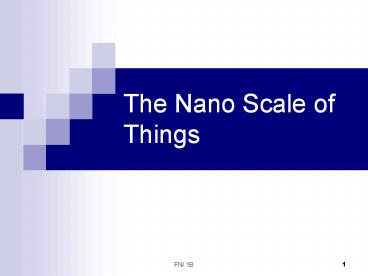The Nano Scale of Things PowerPoint PPT Presentation
1 / 23
Title: The Nano Scale of Things
1
The Nano Scale of Things
2
Why nano?
The nanometer scale is where the sciences come
together
Physics
Biology
Chemistry
New properties begin to emerge at the nanoscale.
3
Metric System is made up of
- Basic units
- Metric Prefixes
- Derived units
4
Metric System
Physical Property Metric Units (abbreviation)
Length Meters (m)
Mass (Weight) Grams (g)
Time Seconds (s)
Temperature Centigrade (C)
Electric Current Amperes (A)
Volume Liter (L)
5
Metric Prefixes
Prefix, abbreviation Means Power of 10
Giga, G Mega, M kilo, k centi, c milli, m micro, µ nano, n 1 billion 1 million 1 thousand 1/100 1/1,000 1/1,000,000 1/1,000,000,000 109 106 103 10-2 10-3 10-6 10-9
6
Common Metric System Units
- centimeter, cm
- millimeter, mm
- kilometer, km
- kilogram, kg
- cubic centimeter, cc
7
Unit Factor Conversion
100 cm 1 m
Every equality gives two conversion factors
written as fractions.
8
Unit Factor Conversion
Choose the factor that will cancel the original
units.
200 cm ? m
200 cm x m
9
Unit Factor Conversion
Unit factor conversion is the method used to
convert from one set of units to another. To
convert from one to another we need a unit
factor, something equal to 1. 1 m 109
nm This results in two conversion factors
written as fractions
and
http//blowers.chee.arizona.edu/cooking/units.html
10
Scientific Notation
- 2.998 x 108 m/s
- Scientific notation is written as a product of a
decimal number and a power of 10. - Scientific notation will have one non-zero digit
to the left of the decimal point.
11
Scientific Constants
Speed of Light c 2.998 x 108 m/s Plancks
constant h 6.626068 x 10-34 m2kg/s Boltzmanns
constant kB 1.3807 x 10-23 J/K Gas constant R
8.3145 J/(mol K)
12
Measurements
-57.8 kcal/mol
Three parts to a measurement Value -57.8
Magnitude combined with units k Units
kcal/mol
13
Display
Registers
Turns on the calculator
Clears the last number entered
All clear clears calculation
Multiplication
Digits 0-9
Division
Subtraction
Addition
Tells what number your calculations equals.
Decimal Point
14
Log10 and antilog10 Dont confuse this with
scientific notation
Square and Square root button
Natural log and anti log (Eulers constant)
Used to get the yellow functions
Trig functions
Easy fraction button
Exponentiation button Dont confuse with
scientific notation
Changes the sign
Memory recall and store
Parentheses control priority
Close parentheses and invert button
Used to enter scientific notation Sometimes EE
15
Calculator PracticeUse the EE/EXP button
Do with EE or EXP 5 x 102 10 x 103 1 x 103
2 x 10-3 103 103 x 101
Do with 10x button 5 x 102 10 x 103 1 x 103
2 x 10-3 103 103 x 101
You should get the same answers
16
Common Unit Conversions used in Nanoscience
1 m 100 cm 1 m 1,000 mm 1 m 1,000,000 µm
106 µm 1 m 1,000,000,000 nm 109 nm 1 m
10,000,000,000 Å 1010 Å 1 cm 107 nm 1 cm
108 Å 1 mm 1,000 µm 1 µm 1,000 nm 1 µm
10,000 Å
17
Reading a Vernier Scale
18
http//www.sc.doe.gov/bes/Scale_of_Things_07OCT03.
19
(No Transcript)
20
Example
Magnification 100 X Feature size 10 cm What
is the actual size in cm? What is the actual
size in m? What is the actual size in microns?
21
Unit Factor Conversion
Examples Convert 650 nm to µm Convert 20 nm to
angstroms Convert 2000 Å to µm
22
Scale of Things Lab
http//www.cellsalive.com/howbig.htm
23
(No Transcript)

